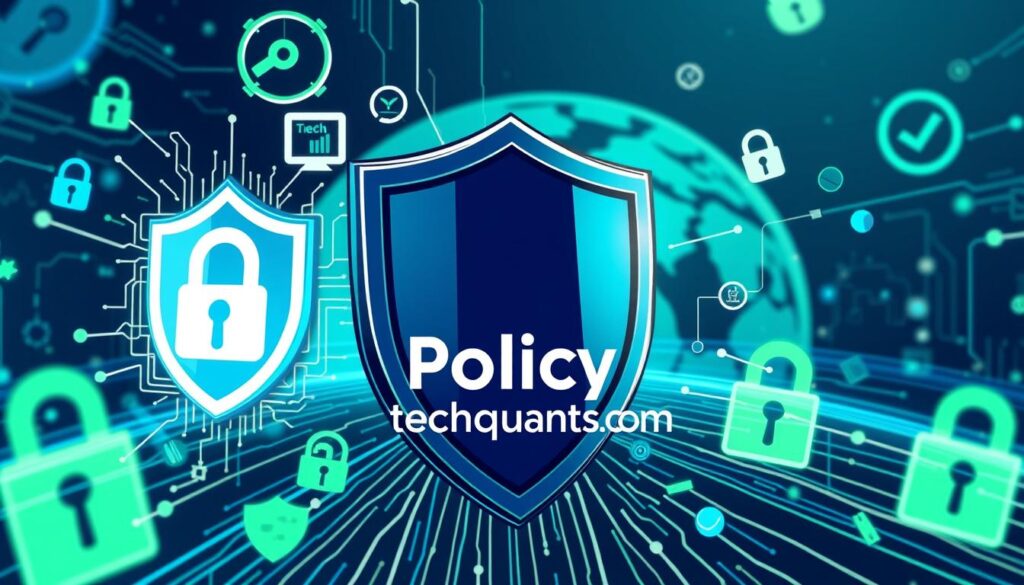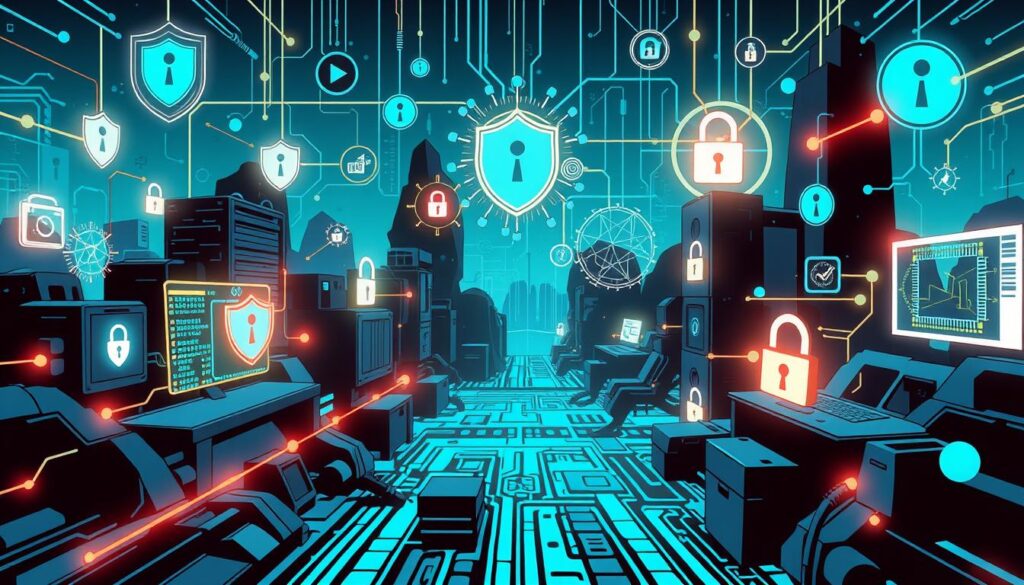In the world of cybersecurity, knowing CISSP Domain 1 is key. It’s all about security and risk management. These are crucial for keeping digital assets safe. You’ll learn how to protect data from cyber threats like malware and ransomware.
This guide will give you deep insights into CISSP Domain 1. You’ll learn about security measures and risk management strategies. You’ll see why following standards like GDPR and HIPAA is important. You’ll also learn how to create strong security policies. Your journey in cybersecurity begins here, building a solid foundation for your career.
Key Takeaways
- CISSP Domain 1 emphasizes the significance of security and risk management in a comprehensive cybersecurity framework.
- Regulatory compliance, such as GDPR and HIPAA, is vital in safeguarding organizations against legal repercussions.
- Effective development and maintenance of security policies are crucial for protecting sensitive information.
- Understanding common cyber threats enables proactive measures for risk reduction.
- Continuous monitoring allows organizations to stay ahead of emerging security challenges.
Introduction to CISSP Domain 1
CISSP, or Certified Information Systems Security Professional, is a top mark in cybersecurity. It focuses on security management and risk management. These are key for those wanting to grow in cybersecurity.
The CISSP intro is your first step into cybersecurity. It teaches you about risk management basics. This knowledge helps you tackle security challenges in any organization.
CISSP Domain 1 covers security policies, legal standards, and risk assessments. Keeping up with security trends is crucial for your career.
Being a CISSP candidate means you’re learning essential skills. These skills prepare you for important roles in cybersecurity.
Understanding Security and Risk Management
Learning about security management and risk management is key to making good cybersecurity plans. IT pros need to keep up with new ways to protect data. They must always be learning to stay ahead in this field.
The CISSP exam is a top test in info security. It focuses a lot on security and risk management, with 16% of its questions on these topics. Knowing these areas well helps you deal with cybersecurity’s tough issues.
As tech gets better, so do the problems for companies. Using risk management tools helps you find and fix weak spots. This way, you can make plans to lower risks.
Getting a CISSP certification is tough, with a 20% pass rate. To pass, you need a good study plan. This should include books, practice tests, and talking with others to really understand security and risk.
In short, knowing about security and risk management is crucial for making strong cybersecurity plans. It prepares you to face future challenges with confidence and knowledge.
Key Concepts in CISSP Domain 1
Learning the basics of CISSP Domain 1 is key to a strong security foundation. It focuses on the CIA Triad and risk assessment frameworks. Knowing these helps you create strong security plans.
Confidentiality, Integrity, and Availability (CIA Triad)
The CIA Triad has three main parts: confidentiality, integrity, and availability. Each is crucial for protecting information. Confidentiality keeps sensitive info safe from unauthorized access. Integrity ensures data is accurate and trustworthy. Availability makes sure info is there when needed, keeping business running smoothly.
Risk Assessment Frameworks
Risk assessment frameworks help find, check, and fix potential risks. They show how to look at vulnerabilities and threats. Using frameworks like NIST SP 800-37 and ISO/IEC 27005 helps your organization stay ahead of security issues.
| Component | Description | Importance |
|---|---|---|
| Confidentiality | Protecting information from unauthorized access. | Maintains privacy and safeguards sensitive information. |
| Integrity | Ensuring data accuracy and preventing unauthorized alterations. | Fosters trust and reliability in information. |
| Availability | Ensuring timely access to information when needed. | Supports business operations and service delivery. |
| Risk Assessment Frameworks | Structured approaches for identifying and mitigating risks. | Aids in proactive security management. |
Importance of Compliance and Legal Issues
In today’s world, following regulatory standards is key. Companies must have strong security and follow laws like GDPR and HIPAA. Not following these rules can cause big financial losses and harm a company’s reputation.
Regulatory Standards (e.g., GDPR, HIPAA)
Standards like GDPR and HIPAA help keep sensitive info safe. To follow these rules, companies must:
- Use strict data handling rules
- Do regular checks to make sure they follow the rules
- Train staff on how to protect data
Following these rules helps avoid data breaches. It builds trust with clients and keeps your company safe legally.
Impact of Non-Compliance
Not following rules can be very bad. Companies that don’t meet standards might face:
- Big fines that can cost millions
- Loss of business because of lost trust
- More attention from regulators
Not following rules can hurt a company’s brand and lead to legal problems. So, focusing on compliance shows you care about doing the right thing. It also helps you stay ahead in a fast-changing market.
| Regulatory Standard | Key Focus | Consequences of Non-Compliance |
|---|---|---|
| GDPR | Data Protection and Privacy | Fines up to €20 million or 4% of global turnover |
| HIPAA | Security for Health Information | Fines ranging from $100 to $50,000 per violation |
CISSP Domain 1: Security and Risk Management
The Certified Information Systems Security Professional (CISSP) is a top cybersecurity credential. It focuses on security and risk management to protect organizations. These practices help keep information safe and align with cybersecurity standards.
The CISSP covers many areas, including security and risk management. It combines these with asset security, communication, and network security. Staying updated with training and education is key to keeping up with industry changes.
Connecting with cybersecurity experts is very helpful for your career. Networking can lead to mentorship and teamwork. Practical experience through internships or projects is also important for your growth.
| Aspect | Importance | Recommended Approach |
|---|---|---|
| Risk Assessment | Identifies potential threats and vulnerabilities | Utilize frameworks like NIST SP 800-30 |
| Policy Development | Sets clear guidelines for security practices | Implement comprehensive security policies |
| Training and Awareness | Equips employees with essential knowledge | Conduct regular training sessions |
| Incident Response | Ensures readiness to handle security breaches | Develop an incident response plan |
By using these practices, you make your organization strong. Keep learning and using cybersecurity frameworks to fight off new threats.
Developing an Effective Security Policy
Creating a strong security policy is key to protecting your organization’s assets and data. It acts as a guide for your team, helping them follow security standards and avoid risks. Knowing how to make this policy can make your organization more secure against threats.
Components of a Security Policy
A good security policy has several important parts. These parts work together to offer a solid security plan. Here are some key elements to include:
- Purpose and Scope: This part explains the policy’s goals and what it covers.
- Roles and Responsibilities: It outlines who does what to keep security strong.
- Acceptable Use Policies: It tells employees how to use company resources like computers and software.
- Data Classification: It talks about the different kinds of data and how to protect it.
- Incident Response: It shows how to handle security breaches and who does what.
- Training and Awareness: It stresses the importance of keeping employees informed about security.
Policy Review and Updates
Security policies can’t stay the same. They need regular updates to keep up with new threats and technology. Having a set time for policy reviews helps your organization stay ahead of security issues. Here are some tips for reviewing your policy:
- Do reviews at least once a year.
- Update the policy after big incidents or when technology changes a lot.
- Get feedback from different departments during reviews.
- Keep track of all changes and why they were made.
Outdated security policies can leave your organization open to risks. By carefully reviewing and updating your policy, you can keep your organization safe from threats.

Identifying and Managing Risks
Keeping your organization safe and strong against threats is key. You need a plan to find, check, and fix risks. This lets you make smart choices to keep your security up. Knowing how to manage risks helps you tackle all possible dangers before they hit.
Risk Management Process
The risk management process has several important steps. Each step is vital for spotting and fixing risks. Here are the main steps:
- Risk Identification: First, you find all the possible risks that could harm your organization. You can use brainstorming, interviews, and workshops to find them all.
- Risk Assessment: Next, you check each risk to see how likely it is and how big the impact could be. This helps you know which risks to tackle first.
- Risk Mitigation: After checking, you come up with plans to deal with the risks. You might avoid them, accept them, transfer them, or control them.
- Monitoring and Review: It’s important to keep watching the risks and check if your plans are working. This way, you can spot new risks fast.
Tools for Risk Assessment
There are many tools and methods to help with risk assessment. They make managing risks easier and more organized. Here are some common ones:
- Risk assessment matrices: These tools help you sort risks by how likely they are and how big the impact could be.
- Software solutions: Programs like RiskWatch and iAuditor help you do risk assessments and manage risks well.
- SWOT analysis: This tool looks at your strengths, weaknesses, opportunities, and threats. It helps you see what’s inside your organization and what’s outside.
- ISO standards: Following ISO 31000 gives you a solid way to add risk management to your organization’s plans.
Using these tools and following a clear process helps your organization find and deal with risks better. This way, you make choices that strengthen your security.
| Step | Description |
|---|---|
| Risk Identification | Systematically identify potential risks through various techniques. |
| Risk Assessment | Evaluate identified risks based on likelihood and impact to prioritize actions. |
| Risk Mitigation | Develop strategies to address the risks identified during the assessment. |
| Monitoring and Review | Continuously monitor risks and review strategies to ensure effectiveness. |
The Role of Security Controls
Understanding security controls is key to better cybersecurity. These controls protect against cyber threats, keeping your organization safe. They help spot, stop, and lessen risks.
Types of Security Controls
There are three main types of security controls:
- Administrative Controls: These are policies and procedures that guide security. They include training and hiring practices.
- Technical Controls: This group includes tools like firewalls and encryption. They enforce security.
- Physical Controls: These protect physical assets. Examples are cameras and security guards.
Implementing Controls in Organizations
Organizations need to focus on practical steps for security control implementation. Key actions include:
- Checking current security to find gaps.
- Creating a clear security policy for all employees.
- Adding security technologies smoothly to existing systems.
- Keeping security controls up to date with new threats.
Combining different controls through a strong security framework is crucial. A solid approach improves security, lowers risks, and supports growth.

| Type of Control | Description | Examples |
|---|---|---|
| Administrative | Policies and procedures that govern security practices. | Security awareness training, incident response plans |
| Technical | Technologies that provide automated security measures. | Firewalls, anti-virus software, intrusion detection systems |
| Physical | Measures designed to protect physical assets. | Access control systems, security guards, surveillance cameras |
Continuous Monitoring and Improvement
In the fast-changing world of cybersecurity, keeping a close eye on security is key. Companies must focus on this to quickly spot and fix threats. This approach not only meets rules but also boosts security overall.
Importance of Ongoing Risk Assessment
Regular risk checks help find weak spots and threats that could harm your business. By always watching, you can catch new risks fast. The main benefits are:
- Proactive Threat Detection: Spotting risks early lowers the chance of attacks.
- Informed Decision-Making: Regular checks help update security plans with the latest info.
- Regulatory Compliance: Staying in line with rules means always checking your security steps.
Metrics for Security Performance
It’s crucial to have good security metrics to see if your efforts are working. You should watch different signs to see how well your security is doing. Important metrics include:
| Metric | Description | Benefits |
|---|---|---|
| Incident Response Time | How fast you respond to security issues. | Makes your response quicker and less damaging. |
| Number of Vulnerabilities Detected | All vulnerabilities found over time. | Shows how good your monitoring and risk checks are. |
| Compliance Rate | How well you follow security rules. | Keeps you in line with laws and lowers legal risks. |
| User Awareness Levels | How well employees know about cybersecurity. | Boosts your security culture and cuts down on mistakes. |
By looking at these metrics often, you can make your security better. Always watching and checking risks turns security into a forward-thinking plan. This keeps your company safe from new cyber threats.
Conclusion
Understanding CISSP Domain 1: Security and Risk Management is key for a cybersecurity career. This certification is highly respected, covering important areas for information security. It helps you build a strong foundation in security and risk management.
By mastering these areas, you improve your technical skills. You also become a valuable asset in a constantly changing field. This is crucial for your career growth.
As you move forward in your cybersecurity career, keep learning and gaining practical experience. Internships, projects, and networking with professionals are important. They help you stay updated with the latest in the field.
Getting additional certifications, like CompTIA Security+ and Certified Ethical Hacker, can also boost your skills. This expands your professional opportunities.
The path to CISSP certification and beyond offers many chances for growth. Approach this journey with dedication and excitement. Use your knowledge to face cybersecurity challenges head-on.
Your hard work will not only help you succeed but also protect organizations’ information worldwide. It’s a vital role in keeping data safe.
FAQ
What is CISSP Domain 1?
CISSP Domain 1 deals with Security and Risk Management. It covers key principles for following cybersecurity rules. Knowing these principles is key to keeping sensitive data safe from cyber threats.
Why is security and risk management important in cybersecurity?
Security and risk management are key in cybersecurity. They help spot, check, and lower risks. This keeps digital assets safe, protecting companies from big financial and reputation losses.
What is the CIA Triad?
The CIA Triad are the three main parts of info security: Confidentiality, Integrity, and Availability. Knowing these is crucial for strong security in any framework.
How does compliance impact cybersecurity?
Following rules like GDPR and HIPAA is vital in cybersecurity. Not following them can lead to big legal problems, harm to reputation, and financial losses. Knowing these rules helps professionals deal with these issues well.
What are security policies, and why are they important?
Security policies are rules that guide how an organization handles security. They are key for setting clear security goals and practices. They help lower risks and keep up with changing security rules. Keeping these policies up to date is important for facing new threats.
What role do security controls play in cybersecurity?
Security controls protect an organization’s info systems. They can be admin, tech, or physical controls. Using them well strengthens cybersecurity, helping stop data breaches.
What is the significance of continuous monitoring in cybersecurity?
Continuous monitoring checks security levels and weaknesses often. It lets organizations quickly respond to new threats. It keeps security measures strong, promoting ongoing improvement in cybersecurity.
How can professionals stay updated on evolving cybersecurity trends?
Professionals can keep up by learning continuously. They can do this through certifications, online courses, industry events, and reading relevant publications. This knowledge helps them keep up with new tech and threats.
Source Links
1 . Top Cybersecurity Interview Questions and Answers for 2025
2 . 24 Cutting-Edge Artificial Intelligence Applications | AI Applications in 2024
3 . 20+ IT Certifications with the Highest Pay
4 . 25 New Technology Trends for 2025 | Emerging Technologies 2025
- My Guide to Understanding Data Centre Architecture: Core Components Every IT Pro Should Know
- Wazuh Home Network Setup: A Step-by-Step Guide
- Quantum Computers Decrypting Blockchain: The Risks and Implications
- Wazuh: Enterprise-Grade Security for Your Business
- Wazuh for Beginners: A Comprehensive Guide
Related posts:
 CISSP Domain 2: Guide to Asset Security Fundamentals
CISSP Domain 2: Guide to Asset Security Fundamentals
 CISSP Domain 3: Security Architecture and Engineering
CISSP Domain 3: Security Architecture and Engineering
 Explore CISSP Domain 5: Identity & Access Management
Explore CISSP Domain 5: Identity & Access Management
 CISSP Domain 4: Communication and Network Security
CISSP Domain 4: Communication and Network Security
 CISSP Domain 6: Security Assessment and Testing Guide
CISSP Domain 6: Security Assessment and Testing Guide
 CISSP Domain 7: Security Operations Essential Guide
CISSP Domain 7: Security Operations Essential Guide
